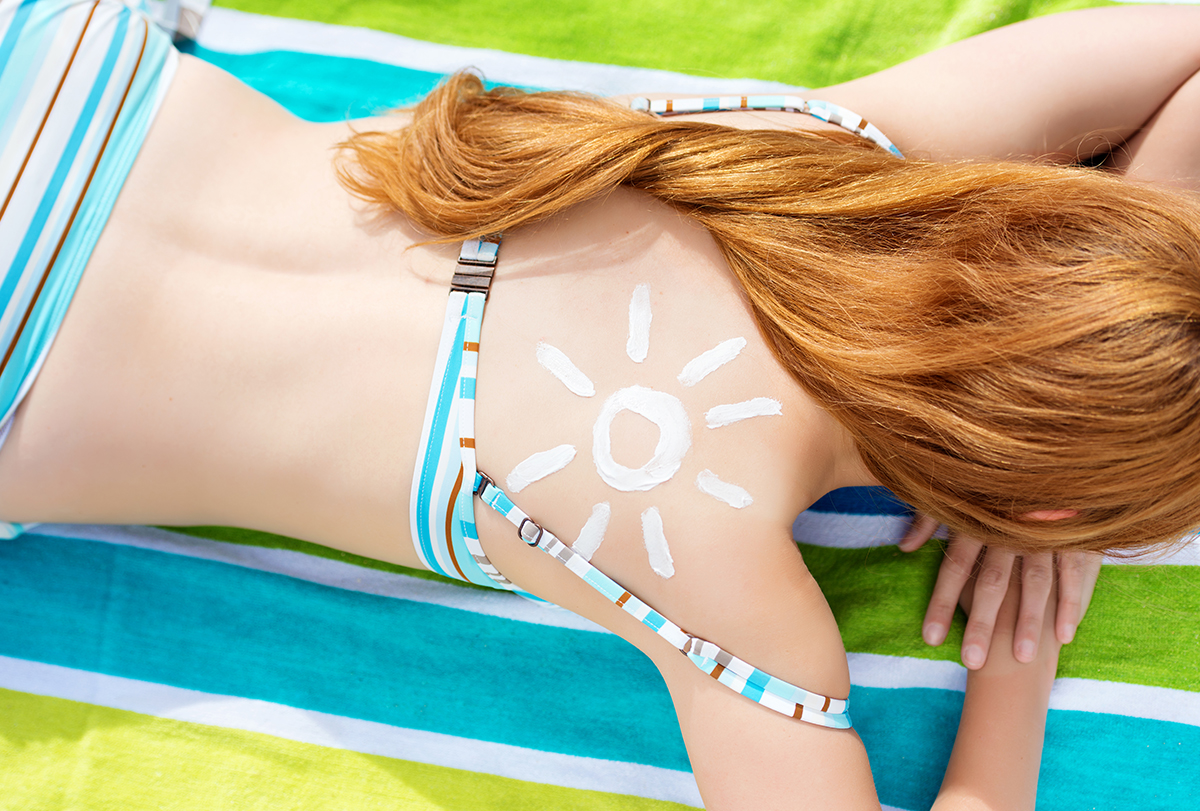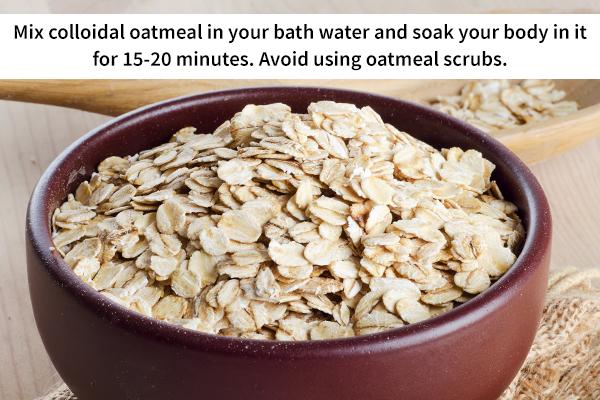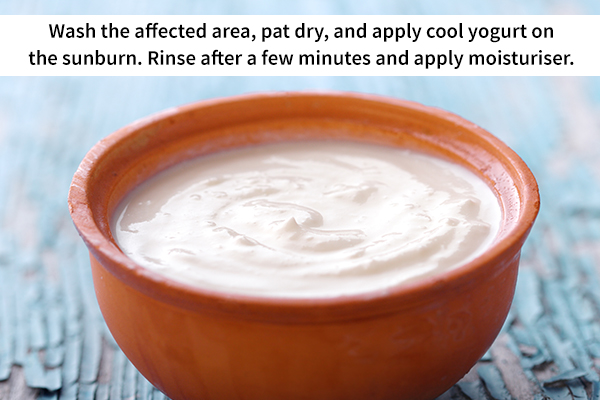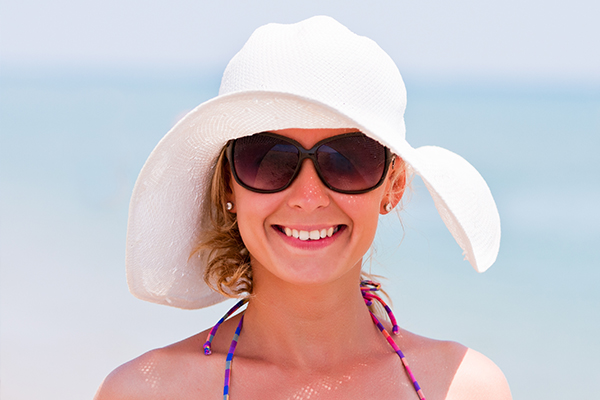In this article:
Moderate exposure to sunlight is the chief source of vitamin D and can also get you a beautiful tan. However, prolonged sun exposure through the years can contribute to age spots, premature wrinkling, and an increased risk of skin cancer.

Moreover, spending excessive time under the sun, especially without sunscreen, can result in a painful sunburn. The treatment for a sunburn depends on the degree of burn. While severe sunburns require medical treatment, you can manage mild sunburns with home-based interventions.
Home Remedies for Sunburns
The following at-home treatments can help treat mild sunburns:
1. Apply aloe vera gel
Aloe vera gel is a popular home remedy for various skin problems, including burns. It possesses anti-inflammatory, moisturizing, (1) and anti-itch properties (2) that can help manage the symptoms of a sunburn.
How to use:
Wash the affected area with cold water and pat it dry using a clean towel. Apply fresh, cold aloe vera gel or aloe-based lotion to the area twice a day until it heals. Avoid using alcohol-containing products as they may irritate the burnt skin.
2. Take an oatmeal bath

Oatmeal is effective in treating sunburns due to its moisturizing properties that can help alleviate the discomfort associated with flaky, dry skin. (3) Moreover, colloidal oatmeal contains antioxidants that help control inflammation. (4)
How to use:
Mix colloidal oatmeal in your bath water and soak your body in it for 15–20 minutes. Avoid using oatmeal scrubs.
3. Apply honey
Honey can help heal wounds and treat mild burns, among its various uses. (5) Since the sunburnt skin often turns flaky and dry and develops blisters, the antiseptic and anti-inflammatory properties of honey can support recovery and prevent infections associated with blisters. (6)
It is vital to use only medical-grade honey, which is sterilized, for the treatment of burns.
How to use:
Wash the affected area with cold water and pat it dry. Apply honey gel or paste to the burn and wash after 15 minutes. Discontinue use if it stings.
4. Use a cool tea compress
The tannins in tea act as an anti-inflammatory agent, thus helping in the treatment of sunburns. (7)
How to use:
Brew a cup of green or black tea and cool it in the refrigerator. (8) Soak a clean cloth with the tea and apply it to the affected area. Pour some more tea on the cloth. You can also add mint leaves when brewing the tea to enhance its cooling effects.
5. Dab some witch hazel
Witch hazel is rich in polyphenols that help reduce inflammation and promote wound healing. (9) It is suggested that witch hazel-based emollients can help boost skin recovery in mild sunburns.
6. Use yogurt

Yogurt has been a popular anecdotal remedy in the treatment of sunburns, although no scientific evidence supports its use.
How to use:
Wash the affected area, pat it dry, and apply cool yogurt. Rinse after a few minutes and apply moisturizer.
7. Make a vinegar compress
The use of apple cider vinegar and white vinegar is another anecdotal remedy for the treatment of sunburn.
Vinegar can help reduce the flakiness and itching associated with sunburn. However, there is no scientific evidence to support this remedy, and therefore it should be used with caution. Discontinue treatment if burning or itching is felt. (10)(11)
How to use:
Soak a clean cloth in diluted vinegar and apply it to the affected area.
Self-Care Measures for Sunburnt Skin
Along with the given home remedies, the following measures can also promote healing and reduce discomfort:
- Take cold baths.
- Apply moisturizer on the burnt area to soothe and nourish the skin. You can use coconut oil, milk, shea butter, or cocoa butter for the same.
- Use a bandage if your skin develops blisters in order to prevent an infection.
- Avoid the use of alcohol on the burn.
- Do not venture out under the sun until the redness, pain, and peeling disappear.
- Consume plenty of fluids and stay hydrated.
- Apply cold compress.
- Avoid the use of soaps on the sunburnt skin.
- Take OTC pain medications if necessary.
How to Prevent Sunburns

It is fairly easy to prevent your skin from getting burnt in the first place than going through the pain, redness, and flakiness associated with a sunburn. Prevention also helps avert permanent DNA damage from UV rays that can cause aging and skin cancer. The following preventive measures are useful:
1. Slip on protective clothing
It is recommended to wear loose-fitting but tightly woven clothes to protect your skin from UV radiation.
2. Slop on some sunscreen
The World Health Organization (WHO) recommends applying sunscreen with at least SPF 15 to your skin 20 minutes before going out in the sun, followed by reapplication every 2 hours. You must also reapply the sunscreen after swimming, exercising, or playing outdoors. (12)
You can use broad-spectrum sunscreens available in the forms of gels, ointments, wax sticks, creams, and lotions, preferably those containing titanium dioxide and zinc oxide. You should also apply lip balms with SPF 30 to protect your lips.
3. Slap on a hat
Use a broad-brimmed or legionnaire-style hat that can help protect your head, face, ears, and neck from direct sunlight and UV rays.
4. Seek shade
It is advised to stay under the shade, especially between 12–3 pm when the sun is at its strongest.
5. Slide on sunglasses
Sunglasses can help protect your eyes from sunburn, macular degeneration, cataract, and pterygium, all of which can lead to blindness.
6. Use a UV index scale tool
A UV index scale tool identifies peak UV times, which can help in taking precautions. It is a highly useful tool for farmers as they spend most of their time working outdoors.
7. Avoid tanning beds
The UV rays from tanning beds can also cause skin cancer, sunburn, and wrinkling. You may use self-tanning products, but make sure to use sunscreen with them.
8. Avoid exposing your babies and toddlers to sunlight
Since the use of sunscreen is not recommended for children below 6 months of age, it is best to prevent them from sun rays. Try to keep your toddlers in the shade, and dress them in full-sleeved garments and other protective clothing.
Most-Asked Questions About Sunburns

Can sunburn preventive measures affect vitamin D levels in the body?
The use of sunscreen can lower vitamin D production in the skin and will have a drastic effect on vitamin D levels in the body.
A few minutes of sunlight in the morning or late afternoon, when the UV levels are low, are enough to stimulate vitamin D production in the body. Therefore, it is important to follow sensible sun protection, rather than avoiding sunlight at all times.
Does tanning protect the body from skin disorders?
A skin tan cannot prevent UV rays from penetrating the skin. Therefore, it doesn’t lower the risk of skin or eye damage or even skin cancer.
Can a baking soda bath help treat a sunburn?
Many people use pastes made of baking soda and water on their sunburnt skin or add baking soda to their baths to help relieve the itching associated with sunburns. (13) This remedy has not been clinically studied, and it is best to avoid its use as there are various other proven remedies available.
Can essential oils be used to prevent or treat sunburn?
A few studies have shown the potential use of essential oils in treating different aspects of traumatic burns, but no study has assessed their use for healing burnt skin directly. (14)
Anecdotally, peppermint and lavender essential oils mixed with carrier oils or aloe vera gel have been observed to help sunburnt skin due to their cooling effect. (15) However, they have no use in preventing sunburns as their SPF value is extremely low. (15)
Final Word
Sunburns are a common nuisance that can cause pain and peeling of the skin. Moreover, they may have long-term damaging effects, including skin cancer.
It is recommended to protect yourself from sunburn by wearing protective clothing, using sunscreens, and avoiding prolonged sun exposure. If you do get mild sunburn, you can use various home remedies for relief. However, if your sunburn is severe, immediately contact a doctor.

- Was this article helpful?
- YES, THANKS!NOT REALLY


